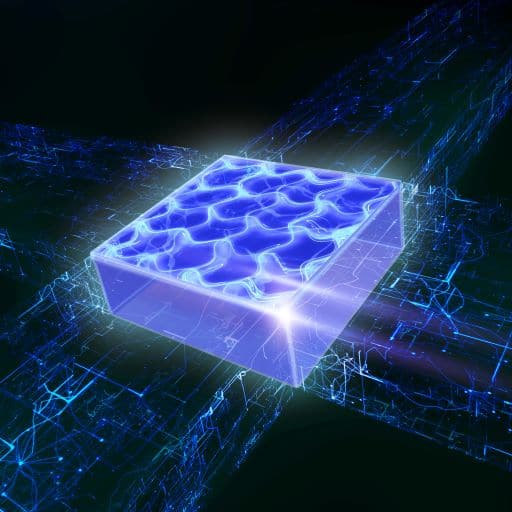Supersolidity enters a second dimension
18 Aug 2021
Atoms in a Bose-Einstein condensate (BEC) can exist in a mysterious “supersolid” state in two dimensions, researchers in Austria have shown. The work, which builds on research from 2019 demonstrating supersolidity in one dimension, opens the way to hitherto impossible tests of theoretical predictions about this long-unexplained phenomenon.
Supersolidity is a counterintuitive state of matter that was first predicted in 1957 by the theoretical physicist Eugene Gross. At temperatures near absolute zero, Gross reasoned that vacancies in crystals of bulk solid helium-4 could condense into a superfluid that would flow through the solid. Gross’ original conjecture remains unproven: a purported 2004 discovery was, in 2012, shown by the same researchers to be the result of experimental error. Subsequent studies have produced nothing definitive.
Physicists have had more success, however, by starting from superfluids and working in the opposite direction. BECs (ultracold gases of trapped atoms all cooled to the quantum ground state of the trap) of highly magnetic atoms can spontaneously form regular, ordered clusters in an applied magnetic field, showing the emergence of supersolidity from a completely isotropic superfluid state. “The atoms inside the gas are all phase coherent, and they figure out that if they pile one on top of the other head-to-tail they can decrease their energy,” explains Francesca Ferlaino, an experimental atomic physicist at the University of Innsbruck and the Institute for Quantum Optics and Quantum Information. “In principle they could try to make an infinite filament, but actually they cannot do this because there is a kinetic energy cost and there is a trapping potential cost.”
Instead, the atoms form a series of regularly spaced piles, leading to a lattice of peaks in their shared wavefunction. This produces a crystalline order in the atoms’ density, even though each individual atom is completely delocalized.
From one dimension to two
That’s the theory. In practice, while three groups – including Ferlaino’s – achieved emergent crystalline order in superfluids in one dimension in 2019, nobody managed it in two dimensions. This severely limited researchers’ ability to perform experiments on supersolidity using quantum gases. “The interesting physics is in the behaviour of the crystals – the transport of the particles, the type of excitations that you can create,” Ferlaino explains. However, creating 2D supersolidity in a quantum gas was expected to be far from trivial: “There was this idea in the community that to reach 2D supersolidity would be much, much more difficult and would require many more atoms that were maybe at the limit of what experiments could do,” she says.
To overcome this barrier, Ferlaino’s group worked with theorists led by Luis Santos of the Institute for Theoretical Physics in Hanover, Germany. By calculating precisely how tailoring the shape of the trapping potential would alter the shape of the wavefunction – and thereby allow the researchers to turn a linear supersolid into a 2D one – the theorists “identified a way to enter into the supersolid state which was not clear”, Ferlaino says.
Using these tailored traps, the experimentalists showed how, depending on the field they applied, cooling the atoms might produce an unmodified condensate, a state comprising separate droplets or – in a very narrow range between the two – a supersolid.
Progress through competition
Giovanni Modugno, a physicist at the University of Florence, Italy whose group (including the theorists in the present work) published another of the 2019 observations of one-dimensional supersolidity, is impressed. “Normally when you have bosonic particles at zero temperature, they go to the ground state of the system, which is a wavefunction with no nodes and no modulations,” he explains. “What is extraordinary here is that we are still in the ground state of the system, but we have these places where the wavefunction almost reaches zero but doesn’t really: from the point of view of textbook quantum mechanics, these modulations are something extraordinary and extremely difficult to realise. That’s why it took 50 years or more.”READ MORE

“The one-dimensional supersolids kind of appeared two years ago and it was a really big surprise when three groups overcame that hurdle,” adds theorist Blair Blaikie of the University of Otago in New Zealand, who was not involved in the latest research. “Maybe because of that competition things have really progressed quite quickly. This two-dimensional system just has a lot more features we expect of a supersolid. There’s still a lot of deep theoretical questions about the transitions between different crystalline arrangements and the nature of the phase transitions, and I think there will be a lot of interest in using this system to answer some of these questions.”
Ferlaino is keen to start answering these questions, too. “Now we’ve produced this new state, we have many things we want to study,” she says. “We want to know, say, the dispersion relation, and to study the out-of-equilibrium dynamics.”
The research is published in Nature.
26/8/2021 FROM PHYSICSWORLD.COM

Δεν υπάρχουν σχόλια:
Δημοσίευση σχολίου